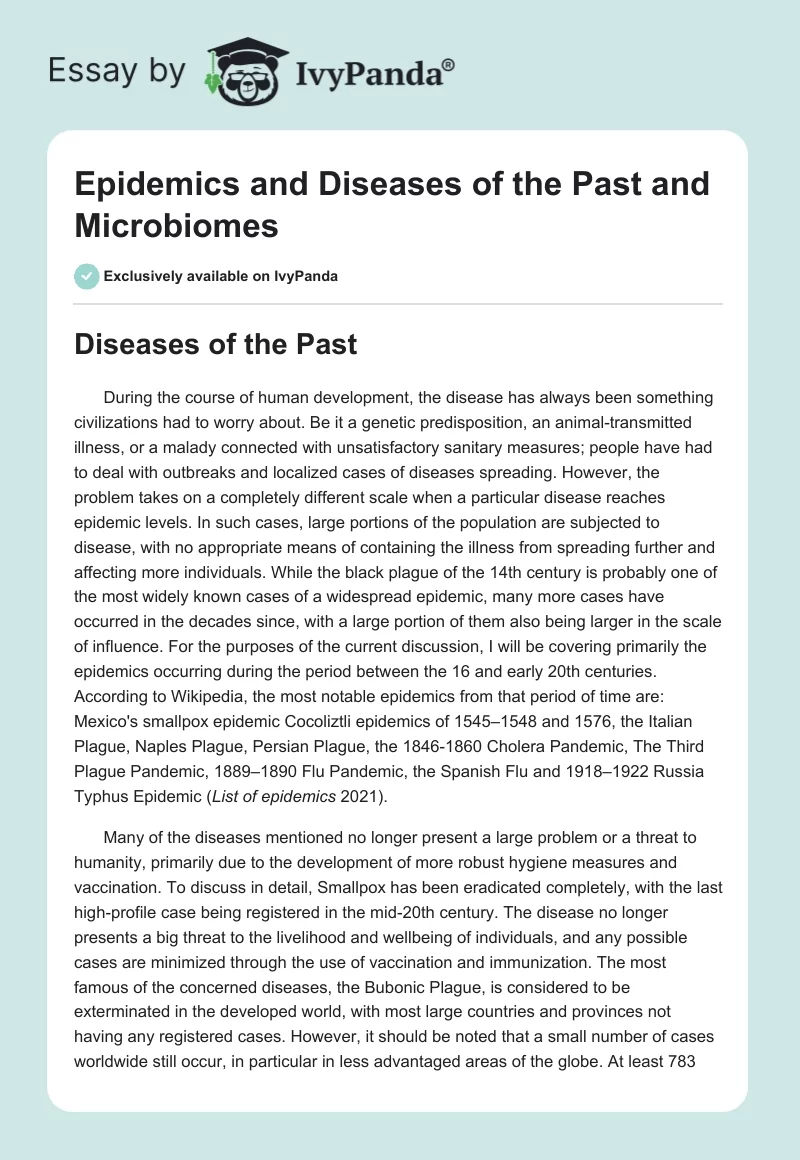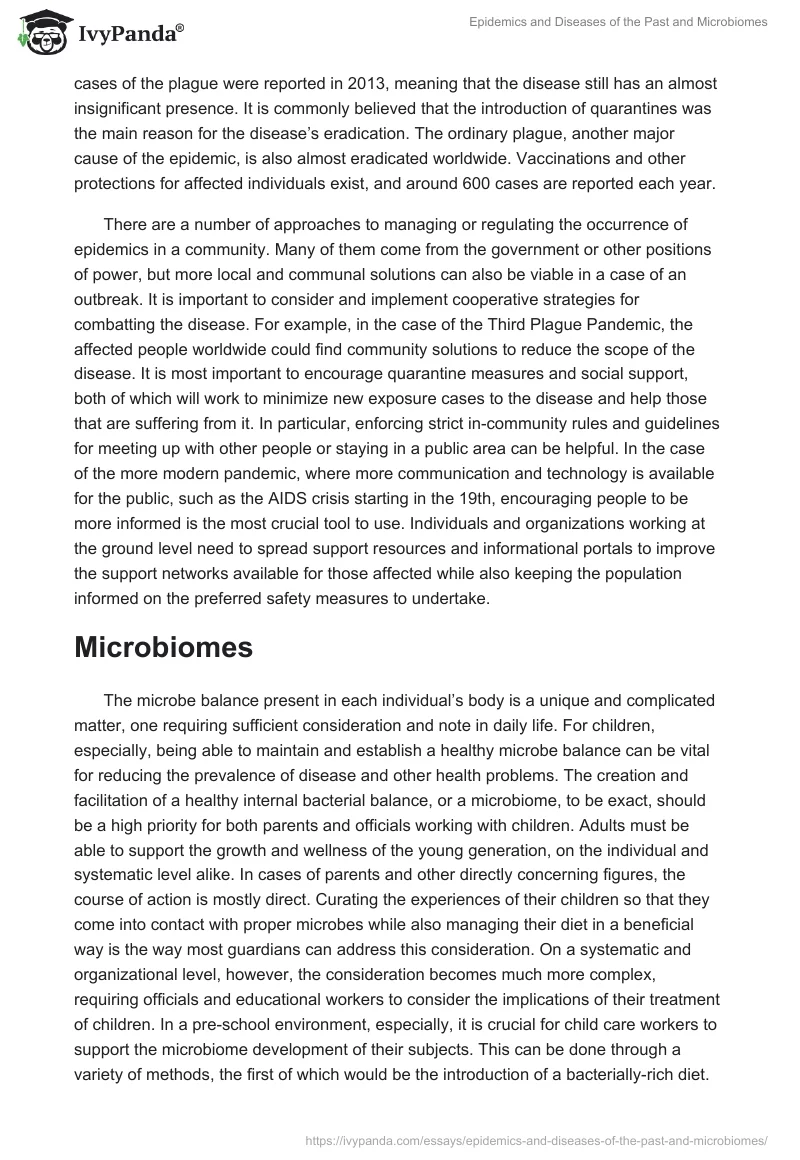Diseases of the Past
During the course of human development, the disease has always been something civilizations had to worry about. Be it a genetic predisposition, an animal-transmitted illness, or a malady connected with unsatisfactory sanitary measures; people have had to deal with outbreaks and localized cases of diseases spreading. However, the problem takes on a completely different scale when a particular disease reaches epidemic levels. In such cases, large portions of the population are subjected to disease, with no appropriate means of containing the illness from spreading further and affecting more individuals. While the black plague of the 14th century is probably one of the most widely known cases of a widespread epidemic, many more cases have occurred in the decades since, with a large portion of them also being larger in the scale of influence. For the purposes of the current discussion, I will be covering primarily the epidemics occurring during the period between the 16 and early 20th centuries. According to Wikipedia, the most notable epidemics from that period of time are: Mexico’s smallpox epidemic Cocoliztli epidemics of 1545–1548 and 1576, the Italian Plague, Naples Plague, Persian Plague, the 1846-1860 Cholera Pandemic, The Third Plague Pandemic, 1889–1890 Flu Pandemic, the Spanish Flu and 1918–1922 Russia Typhus Epidemic (List of epidemics 2021).
Many of the diseases mentioned no longer present a large problem or a threat to humanity, primarily due to the development of more robust hygiene measures and vaccination. To discuss in detail, Smallpox has been eradicated completely, with the last high-profile case being registered in the mid-20th century. The disease no longer presents a big threat to the livelihood and wellbeing of individuals, and any possible cases are minimized through the use of vaccination and immunization. The most famous of the concerned diseases, the Bubonic Plague, is considered to be exterminated in the developed world, with most large countries and provinces not having any registered cases. However, it should be noted that a small number of cases worldwide still occur, in particular in less advantaged areas of the globe. At least 783 cases of the plague were reported in 2013, meaning that the disease still has an almost insignificant presence. It is commonly believed that the introduction of quarantines was the main reason for the disease’s eradication. The ordinary plague, another major cause of the epidemic, is also almost eradicated worldwide. Vaccinations and other protections for affected individuals exist, and around 600 cases are reported each year.
There are a number of approaches to managing or regulating the occurrence of epidemics in a community. Many of them come from the government or other positions of power, but more local and communal solutions can also be viable in a case of an outbreak. It is important to consider and implement cooperative strategies for combatting the disease. For example, in the case of the Third Plague Pandemic, the affected people worldwide could find community solutions to reduce the scope of the disease. It is most important to encourage quarantine measures and social support, both of which will work to minimize new exposure cases to the disease and help those that are suffering from it. In particular, enforcing strict in-community rules and guidelines for meeting up with other people or staying in a public area can be helpful. In the case of the more modern pandemic, where more communication and technology is available for the public, such as the AIDS crisis starting in the 19th, encouraging people to be more informed is the most crucial tool to use. Individuals and organizations working at the ground level need to spread support resources and informational portals to improve the support networks available for those affected while also keeping the population informed on the preferred safety measures to undertake.
Microbiomes
The microbe balance present in each individual’s body is a unique and complicated matter, one requiring sufficient consideration and note in daily life. For children, especially, being able to maintain and establish a healthy microbe balance can be vital for reducing the prevalence of disease and other health problems. The creation and facilitation of a healthy internal bacterial balance, or a microbiome, to be exact, should be a high priority for both parents and officials working with children. Adults must be able to support the growth and wellness of the young generation, on the individual and systematic level alike. In cases of parents and other directly concerning figures, the course of action is mostly direct. Curating the experiences of their children so that they come into contact with proper microbes while also managing their diet in a beneficial way is the way most guardians can address this consideration. On a systematic and organizational level, however, the consideration becomes much more complex, requiring officials and educational workers to consider the implications of their treatment of children. In a pre-school environment, especially, it is crucial for child care workers to support the microbiome development of their subjects. This can be done through a variety of methods, the first of which would be the introduction of a bacterially-rich diet.
Yogurts, milk products, and other foods with the addition of gut bacteria can be extremely important; combining nutrition with microbe benefits the young. A pre-school menu should always contain fresh milk-based products and other products containing live bacteria. As a possibility, it might also be beneficial to let children eat bacteria directly, depending on the circumstances and the possibility of such an action. Additionally, exposure to certain types of environments or objects can be beneficial for the development of healthy microbiomes. In particular, contact with domesticated animals and pets, as well as active play, can be a good way for children to be introduced to the outside work bacterial composition. Having an animal that the children can play with, such as a friendly dog, might be a healthy way to accomplish that goal. Alternatively, a pre-school can regularly invite animal workers to let kids come into contact with the necessary bacteria while also engaging in interactive play. In terms of other types of engagement, it is, of course, important to let children play outside, touch grass and dirt, and play in the elements while being under supervision. The process of regularly taking children to play outside will be good both for promoting children’s cognitive abilities and introducing their bodies to new types of bacteria. Overall, educators and other working professionals should strive to help children experience the world in both a novel and controlled manner. Kids must be encouraged to interact with the environments and objects around them while also being protected from possible dangers of the outside world.
Reference
Wikimedia Foundation. (2021). List of epidemics. Wikipedia. Web.


